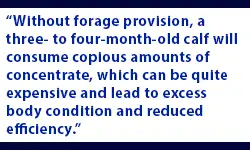
How to introduce forages to youngstock
 By Dr. Lucas Mitchell
By Dr. Lucas Mitchell
I am often asked, “How should forages be introduced to youngstock?”
My answer: “It depends.”
When we are raising calves, I think it is important to recognize this as a two-step process:
- Step 1: Turn them into ruminants.
- Step 2: Let them be ruminants.
Forages may play a role in step 1 and they certainly play a role in step 2.
Step 1: Turn them into ruminants.
Calves are born with an underdeveloped rumen. They are essentially monogastric animals in the first few weeks of their life, and it is the fermentation products of concentrates, primarily starch, that drive rumen development. Rumen development is critical to young calves because it determines their ability to digest dry feeds. This may increase stress at weaning, which can lead to growth slumps and increased incidence of disease. Starter intake in the preweaning period drives rumen development and minimizes stress and risk of setbacks at weaning.
The amount of starter a calf consumes is going to be greatly affected by the amount of milk the calf is offered. However, in this article, I will focus on how starter intake is affected by offering forage. The mainstream line of thinking is that forage shouldn’t be offered in the preweaning period because it suppresses starter intake. However, that is not necessarily true.
The impact of offering forage in the preweaning period depends on the form of starter offered to calves.
- If you’re offering a texturized starter that contains whole or steam-flaked grains, forage should not be offered in the preweaning period because it has been shown to decrease starter intake and, therefore, slow rumen development.
- If you’re offering a pelleted or mashed/meal starter, forage should also be offered in the preweaning period because it has been shown to increase starter intake and, therefore, enhance rumen development.
This difference is likely due to how the two types of starter ferment in the rumen. Pelleted and mashed starters consist of very small particles, which ferment rapidly and cause quick drops in rumen pH. Providing forage along with pelleted and mashed starters will slow fermentation rate and stimulate rumination, which will slow the drop in rumen pH. In contrast, the large particle size of the grains in texturized feeds help stimulate rumination without needing to add forage.
If feeding a pelleted or mashed starter in the preweaning period, I recommend offering a little bit of chopped hay or straw alongside the starter grain. Ideally, the hay or straw would be chopped to an average length of 1 to 2 inches and provided in a bucket beside the grain. Calves will eat very little of the forage, but it will still benefit starter intake. If there isn’t room for a second feed bucket, another option is to mix the chopped hay or straw with the pellet or mashed starter at a rate not exceeding 5% of the mix. If you mix the forage with the starter, calves will sort their feed. If the sorting seems excessive, you may want to try a smaller particle size or reduce how much forage is added. If you have no dry forages on farm, fermented forages may also be suitable if they are of good quality. However, feeding fermented forages will demand more intensive feed management because, if it spoils, calves will not eat it.
 Step 2: Let them be ruminants.
Step 2: Let them be ruminants.
Once the rumen is well developed (in most cases this will be about two weeks post-weaning or around 10 weeks of age), all calves should be offered some forage. The ability of ruminants to utilize fibrous feedstuffs to produce meat and milk is their superpower. It is also what makes them economically feasible and sustainable. Without forage provision, a three- to four-month-old calf will consume copious amounts of concentrate, which can be quite expensive and lead to excess body condition and reduced efficiency. On the other hand, we need to be careful when we start offering forage to calves because young ruminants have limited rumen capacity. If too much forage is fed too soon, growth rates may suffer.
Youngstock that were not previously exposed to forage can be expected to consume large quantities of it over the first few days if allowed. After the first few days, their consumption of forage will slow to reasonable levels. If forage will be offered free-choice, it is important to limit and slowly introduce forage to youngstock.
Forage may also be offered as part of a total mixed ration (TMR) to weaned calves. If offering a TMR, the quality of the forage will determine how much should be initially included. Poor-quality grasses and straw can make up about 5% of the ration dry matter (DM). Better-quality grasses can be included at around 10% of the ration DM. Ensiled forages, like alfalfa haylage and corn silage, can be included at around 15% of the ration DM. Again, offering ensiled forages will demand more stringent bunk management practices to ensure that the feed is cleaned up and the forage is not spoiling. As calves get older, the amount of forage in the ration may be increased as calves will have increased rumen capacity and be better equipped to consume large amounts of forage while maintaining desirable growth rates.
Talk to your local youngstock specialist about the forage introduction strategy that will work best on your farm.
This article was originally written for the March 2021 edition of Vita Plus Starting Strong. Click here for more calf care expertise and practical tips.
About the author: Dr. Lucas Mitchell is a Vita Plus calf and heifer specialist. He grew up working on his family’s dairy farm in Indiana and attended Purdue University, where he received his bachelor’s degree in food science in 2013. He worked in the food industry before returning to academics to pursue a Ph.D. in animal science, with a focus on dairy nutrition, at Penn State University. His research focused on the impacts forage type and quantity have on growth, intake, and metabolism of recently weaned calves. Mitchell provides on-farm support in Michigan, Indiana, and Ohio. He also works closely with the Vita Plus calf team to apply current research and provide custom solutions to meet the needs of calf and heifer raisers.
| Category: |
Calf and heifer nutrition Dairy Performance Feed quality and nutrition |

